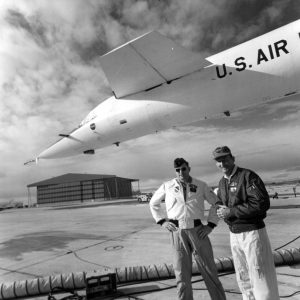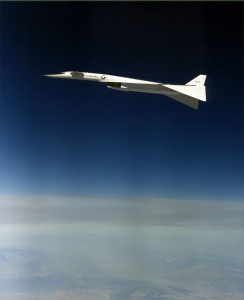4 February 1969 – The North American Aviation XB-70A-1-NA Valkyrie, 62-0001, made its very last flight from Edwards Air Force Base, California, to Wright-Patterson Air Force Base, Ohio. NASA Research Test Pilot Fitzhugh L. Fulton, Jr., Lieutenant Colonel, U.S. Air Force (Retired), and Lieutenant Colonel Emil Sturmthal, U.S. Air Force, were the flight crew for this final flight.

Chris Wamsley/Rockwell via Terry Panopalis

On arrival at Wright-Patterson, Fulton closed out the logbook and handed it over to the curator of the National Museum of the United States Air Force.
The Mach 3+ prototype strategic bomber and high-speed, high-altitude research airplane had completed 83 flights for a total of 160 hours, 16 minutes of flight time.
62-0001 was the first of three prototype Mach 3+ strategic bombers. (The third prototype, XB-70B 62-0208, was not completed.) The Valkyrie utilized the most advanced technology available. Materials and manufacturing techniques had to be developed specifically to build this airplane. It is a large delta wing airplane with a forward canard and two vertical fins. The outer 20 feet (6.096 meters) of each wing could be lowered to a 25° or 65° angle for high-speed flight. Although this did provide additional directional stability, it actually helped increase the compression lift, which supported up to 35% of the airplane’s weight in flight.
The XB-70A is 185 feet, 10 inches (56.642 meters) long with a wingspan of 105 feet (32.004 meters) and an overall height of 30 feet, 9 inches (9.373 meters). Fully loaded, the Valkyrie weighs 534,700 pounds (242,535 kilograms).
It is powered by six General Electric YJ93-GE-3 turbojet engines which were rated at 22,000 pounds of thrust (97.86 kilonewtons) at Sea Level, and 31,000 pounds (137.89 kilonewtons) with afterburner. The J93 was a single-shaft axial-flow turbojet with an 11-stage compressor section and two-stage turbine. It was 235.0 inches (5.969 meters) long, 55.0 inches (1.397 meters) in diameter, and weighed 4,770 pounds (2,164 kilograms).
The maximum speed achieved was Mach 3.1 (2,056 miles per hour, or 3,308.8 kilometers per hour) at 73,000 feet (22,250 meters). The service ceiling is 73,350 feet (23,357 meters).
The second Valkyrie, XB-70A-2-NA 62-0207, was destroyed when it crashed after a mid-air collision with a Lockheed F-104N Starfighter flown by NASA Chief Research Test Pilot Joseph A. Walker, 8 June 1966. Both Walker and the B-70’s co-pilot, Major Carl S. Cross, U.S. Air Force, were killed.
XB-70A Valkyrie 62-0001 is in the collection of the National Museum of the United States Air Force.
